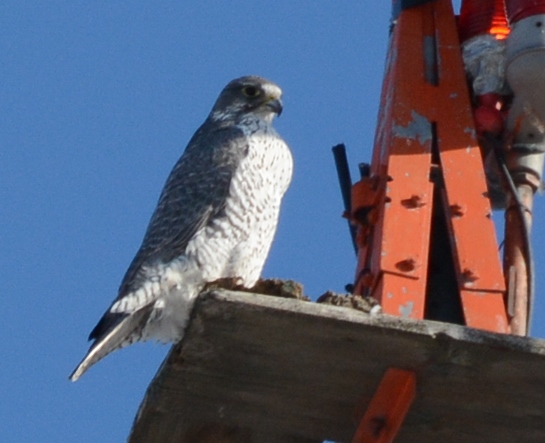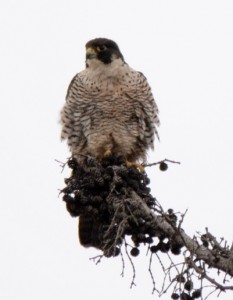
The great white Arctic falcon visits Edmonton, Alberta.
Falcons
Falcons are a family of birds that prey primarily on other birds, but some also eat insects and rodents. They exist in a wide variety of colours and sizes around the world. Most Falcons can be identified by a black malar stripe down the side of their face.
 Peregrine Falcon
Peregrine Falcon
Falcons have swept-back wings, like jet fighter aircraft, that enable them to fly at very high speeds. They use their speed to overtake other birds in flight. The Peregrine can reach speeds of 320 kph (200 mph), making it the fastest animal on the planet. It can be seen worldwide except Antarctica and New Zealand.
Gyrfalcon
The Gyrfalcon is the largest and most beautiful member of the Falcon family. It is a polar Arctic bird found in the Arctic regions of Canada, Alaska, Scandinavia, Russia, Greenland and Iceland, where it is the national bird.
Males are 48 to 61 cm (19 to 24 in) in length, while females are larger, at 51 to 65 cm (20 to 26 in).
The colour varies considerably. Gyrfalcons in the extreme north of Canada, Greenland and Siberia are white with black spots. A bit further south and west in Canada and Alaska, they are white on the front and silver-grey on the back. The most southern residents can be mostly brown or even black, making them difficult to tell from a Peregrine. Most photos show the striking white version, which is the most beautiful.
Gyrfalcon in Edmonton
When the winter temperatures in the high Arctic drop to minus 40 degrees and food is tough to find, Gyrfalcons migrate a bit further south to places like northern Alberta, where it might only be a balmy minus 20. In North America, they seldom venture south of the United States border.
For the past few years, one particular Gyrfalcon has made its winter home in Edmonton, Alberta. It can be found on winter days sitting atop the grain elevator in the city. This building is where farmers bring their grain to be loaded into trains. As a result of the grain, the area has an abundant supply of resident feral pigeons (Rock Pigeon). The Gyrfalcon has only to sit and watch the trains and traffic until it gets hungry and then dive off the building to grab a passing pigeon.
If you have a good set of binoculars or a spotting scope, you can get a nice view of this scarce and beautiful raptor. However, you cannot get close to the building because the trains are parked there loading grain, and there is a high brick wall around the train yard. Due to the height of the building, it would not help to get too close anyway. You have to get away from the building to see what is on top of it.
To photograph the bird, you will need at least a 500mm lens. Even then, my photos are not the greatest due to the distance.
Still, I was thrilled to have a good look at this wonderful bird. It was among the top five of my most wanted North American birds.
